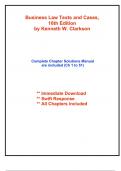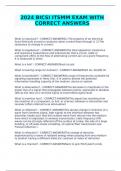Business Law Texts and Cases,
16th Edition
by Kenneth W. Clarkson
Complete Chapter Solutions Manual
are included (Ch 1 to 51)
** Immediate Download
** Swift Response
** All Chapters included
,Solution and Answer Guide
CLARKSON, BUSINESS LAW, TEXT AND CASES, 2025, 9780357985533; CHAPTER 1: LAW AND LEGAL
REASONING
TABLE OF CONTENTS
Answer to Critical Thinking Question in the Feature ............................................................................. 1
Ethics Today—Critical Thinking .............................................................................................................. 1
Answers to Questions in the Practice and Review Feature ..................................................................... 1
Answer to Debate This Question in the Practice and Review Feature of the End of the Chapter ...... 2
Answers to Issue Spotters at the End of the Chapter .............................................................................. 2
Answers to Business Scenarios and Case Problems at the End of the Chapter .................................... 3
Answers to Time-Limited Group Assignment Questions at the End of the Chapter ........................... 7
ANSWER TO CRITICAL THINKING QUESTION IN THE FEATURE
ETHICS TODAY—CRITICAL THINKING
1. Should convicted criminals in Louisiana and Oregon be able to obtain retrials if they have been convicted
in a 10-2 vote of a jury? Why or why not?
Answer: Those who support the Supreme Court decision in Ramos would argue that yes, any person
convicted in Louisiana or Oregon by a 10-5 jury vote should have the ability to appeal. Afterall, if the
non-unanimous jury system in those two states was deemed unconstitutional in 2020, it was clearly
unconstitutional in all prior years.
ANSWERS TO QUESTIONS IN THE PRACTICE AND REVIEW
FEATURE AT THE END OF THE CHAPTER
Suppose that the California legislature passes a law that severely restricts carbon dioxide emissions from
automobiles in that state. A group of automobile manufacturers files suit against the state of California to prevent the
enforcement of the law. The automakers claim that a federal law already sets fuel economy standards nationwide
and that fuel economy standards are essentially the same as carbon dioxide emission standards. According to the
automobile manufacturers, it is unfair to allow California to impose more stringent regulations than those set by the
federal law. Using the information presented in the chapter, answer the following questions.
1. Who are the parties (the plaintiffs and the defendant) in this lawsuit?
Answer: The automobile manufacturers are the plaintiffs, and the state of California is the defendant.
2. Are the plaintiffs seeking a legal remedy or an equitable remedy?
, Answer: The plaintiffs are seeking an injunction, an equitable remedy, to prevent the state of
California from enforcing its statute restricting carbon dioxide emissions.
3. What is the primary source of the law that is at issue here?
Answer: This case involves a law passed by the California legislature and a federal statute; thus the
primary source of law is statutory law.
4. Where would you look to find the relevant California and federal laws?
Answer: Federal statutes are found in the United States Code, and California statutes are published in
the California Code. You would look in these sources to find the relevant state and federal statutes.
ANSWER TO DEBATE THIS QUESTION IN THE PRACTICE AND
REVIEW FEATURE OF THE END OF THE CHAPTER
1. Under the doctrine of stare decisis, courts are obligated to follow the precedents established in their
jurisdictions unless there is a compelling reason not to. Should U.S. courts continue to adhere to this
common law principle, given that our government now regulates so many areas by statute?
Answer: Both England and the U.S. legal systems were constructed on the common law system. The
doctrine of stare decisis has always been a major part of this system—courts should follow precedents
when they are clearly established, excepted under compelling reasons. Even though more common law
is being turned into statutory law, the doctrine of stare decisis is still valid. After all, even statutes have
to be interpreted by courts. What better basis for judges to render their decisions than by basing them
on precedents related to the subject at hand?
In contrast, some students may argue that the doctrine of stare decisis is passé. There is certainly less
common law governing, say, environmental law than there was 100 years ago. Given that federal and
state governments increasingly are regulating more aspects of commercial transactions between
merchants and consumers, perhaps the courts should simply stick to statutory language when disputes
arise.
ANSWERS TO ISSUE SPOTTERS AT THE END OF THE CHAPTER
1. Under what circumstances might a judge rely on case law to determine the intent and purpose of a statute?
Answer: Case law includes courts’ interpretations of statutes, as well as constitutional provisions and
administrative rules. Statutes often codify common law rules. For these reasons, a judge might rely on
the common law as a guide to the intent and purpose of a statute.
2. After World War II, several Nazis were convicted of “crimes against humanity” by an international court.
Assuming that these convicted war criminals had not disobeyed any law of their country and had merely
been following their government’s orders, what law had they violated? Explain.
Answer: At the time of the Nuremberg trials, “crimes against humanity” were new international
crimes. The laws criminalized such acts as murder, extermination, enslavement, deportation, and other
inhumane acts committed against any civilian population. These international laws derived their
legitimacy from “natural law.”
, Natural law, which is the oldest and one of the most significant schools of jurisprudence, holds that
governments and legal systems should reflect the moral and ethical ideals that are inherent in human
nature. Because natural law is universal and discoverable by reason, its adherents believe that all other
law is derived from natural law. Natural law therefore supersedes laws created by humans (national, or
“positive,” law), and in a conflict between the two, national or positive law loses its legitimacy.
The Nuremberg defendants asserted that they had been acting in accordance with German law. The
judges dismissed these claims, reasoning that the defendants’ acts were commonly regarded as crimes
and that the accused must have known that the acts would be considered criminal. The judges clearly
believed the tenets of natural law and expected that the defendants, too, should have been able to
realize that their acts ran afoul of it. The fact that the “positivist law” of Germany at the time required
them to commit these acts is irrelevant. Under natural law theory, the international court was justified
in finding the defendants guilty of crimes against humanity.
ANSWERS TO BUSINESS SCENARIOS AND CASE PROBLEMS AT
THE END OF THE CHAPTER
1-1. Binding Versus Persuasive Authority. A county court in Illinois is deciding a case involving an issue that
has never been addressed before in that state’s courts. The Iowa Supreme Court, however, recently decided
a case involving a very similar fact pattern. Is the Illinois court obligated to follow the Iowa Supreme
Court’s decision on the issue? If the United States Supreme Court had decided a similar case, would that
decision be binding on the Illinois court? Explain.
Answer: A decision of a court is binding on all inferior courts. Because no state’s court is inferior to
any other state’s court, no state’s court is obligated to follow the decision of another state’s court on an
issue. The decision may be persuasive, however, depending on the nature of the case and the particular
judge hearing it. A decision of the United States Supreme Court on an issue is binding, like the
decision of any court, on all inferior courts. The United States Supreme Court is the nation’s highest
court, however, and thus, its decisions are binding on all courts, including state courts.
1-2. Sources of Law. This chapter discussed a number of sources of American law. Which source of law takes
priority in the following situations, and why?
a. A federal statute conflicts with the U.S. Constitution.
Answer: The U.S. Constitution—The U.S. Constitution is the supreme law of the land. A
law in violation of the Constitution, no matter what its source, will be declared
unconstitutional and will not be enforced.
b. A federal statute conflicts with a state constitutional provision.
Answer: The federal statute—Under the U.S. Constitution, when there is a conflict
between a federal law and a state law, the state law is rendered invalid.
c. A state statute conflicts with the common law of that state.
Answer: The state statute—State statutes are enacted by state legislatures. Areas not
covered by state statutory law are governed by state case law.
d. A state constitutional amendment conflicts with the U.S. Constitution.





